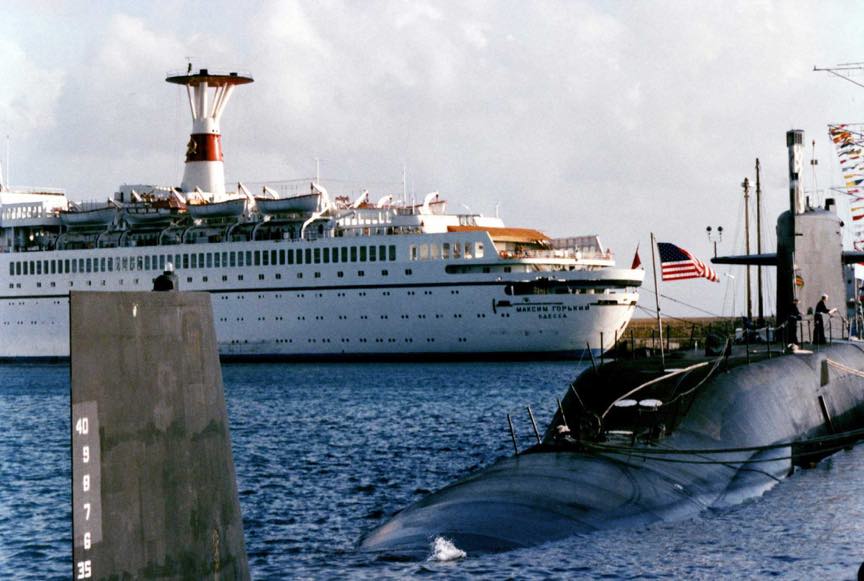Von Steuben SSBN-632

Von Steuben II
(SSBN-632: dp. 7,280 (f.) (surf.), 8,250 (subm.)1. 425'; b. 33', dr. 32'; s. 20+ k.; cpl. 110, a. 16 Polaris mist, 4 21" tt.; cl. Lafagette)
The second Von Steuben (SSBN-632) was laid down on 4 September 1962 at Newport News, Va. by the Newport News Shipbuilding & Dry Dock Co.; lunched on 18 October 1963, sponsored by Mrs. Fred Korth; and commissioned on 30 September 1964, Comdr. John P. Wise (blue crew) and Comdr. Jeffrey C. Metzel (gold crew) in command.
During the fall of 1964, the fleet ballistic missile submarine completed two shakedown cruises-one for each crew-and a period of antisubmarine warfare (ASW) training between the two. On 22 December, the submarine's gold crew fired her first Polaris missile on the Atlantic missile range before returning to Newport News for Christmas. She changed crews again at the beginning of the new year, 1966, and returned to the missile range off Cape Canaveral (then called Cape Kennedy) where the blue crew fired its first missile. In February, after completing all initial training operations, she returned to Newport News.
In March, Von Steuben headed for her first duty assignment. The submarine joined Submarine Squadron (SubRon) 18 at Charleston, S.C., her new base of operations, and immediately began conducting classified deterrent patrols. Her primary mission was and is to deter aggression by providing a highly-mobile launch
platform for her nuclear warhead-bearing Polaris missiles. Since her security and mission would be impaired should any potential enemy learn of her patrol route and activities, that information is highly classified and cannot be recounted here. However, she has conducted more than 30 such patrols since her commissioning, at the rate of four or five per year.
At the end of her 11th patrol early in 1968, Von Steuben was reassigned to SubRon 16 and operated out of Rota, Spain, until the middle of 1969. During that assignment, she visited Groton, Conn., in the summer of 1968 for repairs at the Electric Boat Division of General Dynamics Corp., after which she resumed deterrent patrols out of Rota. In November 1970, she visited Groton once again, this time near the end of a 16month overhaul during which she was modified to carry the newly developed Poseidon C-3 missile. She conducted post-conversion shakedown during the early months of 1971 and fired her first and second Poseidon missiles in February and March, respectively. She returned to Charleston and resumed deterrent patrols in May 1971. Since that time, she continued to make patrols out of Charleston and, recently, also from the submarine base at Holy Loch in Scotland.
In May 1971, she returned to Charleston and resumed strategic deterrent patrols carrying the newer Poseidon missiles. She conducted an Extended Refit Period at Portsmouth Naval Shipyard between March 1978 and May 1978.
Von Steuben's ballistic missile system was upgraded a second time in the early 1980s to use Trident I (C4) ballistic missiles. These missiles were also retrofitted to 11 other SSBNs of the James Madison and Benjamin Franklin classes, replacing their Poseidon missiles, and also were the first missiles carried by the early Ohio-class submarines. Trident missiles were three-stage missiles that provided for increased range along with advances in inertial guidance systems. Von Steuben continued making strategic deterrent patrols into the early 1990s with the Trident I missile.
Decommissioning and disposal
Von Steuben was decommissioned on 26 February 1994 and stricken from the Naval Vessel Register simultaneously. Her scrapping via the Nuclear-Powered Ship and Submarine Recycling Program at Bremerton, Washington, began on 1 October 2000 and was completed on 30 October 2001. Von Steuben's age from delivery to disposal was 37.2 years.
